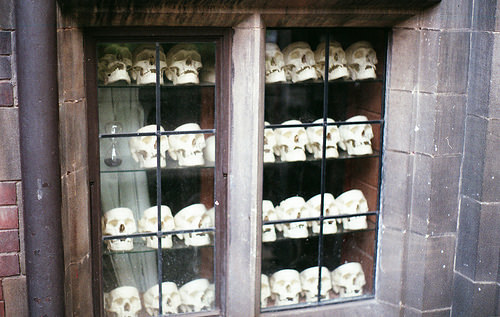Icy Sedgwick's Blog, page 62
June 19, 2015
#FridayFlash – Skulls
I stumbled across the window full of skulls quite by accident. Indeed, one should never seek out such a window with the explicit purpose of doing so. I discovered them whilst walking through the university grounds, passing a small nook beside the art gallery. Having passed that way many times previously, I wondered that I had never seen them before. Naturally I ventured nearer in order that I might better examine them.
I had gone but two steps toward them when I realised that they were not fake skulls, as I had originally supposed. They were real, their grinning jaws missing teeth, while some of them had no lower jaws at all. I drew closer still, and spotted cobwebs strung between those on the top shelf.
One by one, they all turned to face my direction, and I swear that they looked right at me. They looked right into me.
I fled, but I cannot shake the notion that they watch me still. I do not dare open my curtains for fear that I might see them at my window. My housekeeper has turned all of the mirrors to the wall so that they might not peer at me as I go about my day. I have not ventured out of doors for some three days together, and I fear that my absence will soon be commented upon. I content myself that I will leave my lodgings when I am content the skulls are no longer watching.
If I am content…
June 18, 2015
Paying tribute to Sir Christopher Lee
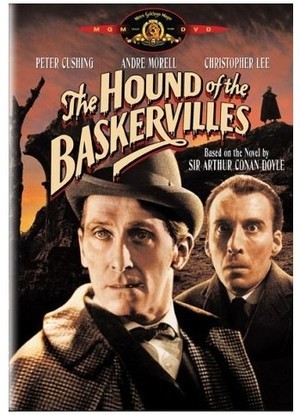 Last week, cinema lost a figure who could legitimately lay claim to the title of ‘legend’. Sir Christopher Lee was one of my favourite actors and I wasn’t originally going to blog about his passing. However, I changed my mind because yesterday I watched the BBC 4 edition of Timeshift about Sherlock Holmes, and it was a genuine pleasure to hear him talk about the late and great Peter Cushing. Obviously Cushing played the eponymous detective in Hammer’s The Hound of the Baskervilles in 1959, while Lee played Henry Baskerville, the intended victim of the family curse. Lee himself played Sherlock in Valley of Fear (1962) and the TV movies Sherlock Holmes and the Leading Lady (1991) and Incident at Victoria Falls (1992). He also played Mycroft Holmes in The Private Life of Sherlock Holmes (1970).
Last week, cinema lost a figure who could legitimately lay claim to the title of ‘legend’. Sir Christopher Lee was one of my favourite actors and I wasn’t originally going to blog about his passing. However, I changed my mind because yesterday I watched the BBC 4 edition of Timeshift about Sherlock Holmes, and it was a genuine pleasure to hear him talk about the late and great Peter Cushing. Obviously Cushing played the eponymous detective in Hammer’s The Hound of the Baskervilles in 1959, while Lee played Henry Baskerville, the intended victim of the family curse. Lee himself played Sherlock in Valley of Fear (1962) and the TV movies Sherlock Holmes and the Leading Lady (1991) and Incident at Victoria Falls (1992). He also played Mycroft Holmes in The Private Life of Sherlock Holmes (1970).
The more I thought about him, the more I wanted to pay tribute to the owner of one of cinema’s finest voices, not only as a diehard devotee of classic horror, but as a fan.

A screenshot from the film Horror Express (1972); Christopher Lee as Prof. Sir Alexander Saxton and Peter Cushing as Dr. Wells.
I think I first encountered Lee through endless repeats of James Bond films on TV, when he played Scaramanga in The Man With The Golden Gun (1974). Later I would watch him as the suave Duc de Richlieu in The Devil Rides Out (1968), and naturally as Dracula (beginning with Dracula in 1958). As much as I loved Jonathan Rhys Meyers in the role, Christopher Lee will always be my Dracula. True, I’ve seen him in some terrible films (The City of The Dead of 1960 and To The Devil A Daughter of 1976 spring to mind) but even when the film around him was awful, I always enjoyed his performances.

Lego Saruman
I was pleased when a new set of fans discovered him through Star Wars and Lord of the Rings, and I think it’s a testament to his screen presence that his career spanned eight decades. He comes across as likeable and charismatic through his autobiography, Tall, Dark and Gruesome, and he always seemed modest and approachable in interviews – a far cry from the monster or villain that he often portrayed on screen. It’s funny to think that it was his height (6′ 5″) forced him to take such roles, yet it was precisely these roles that helped him to become so iconic. Who could forget him as Doctor Catheter in Gremlins 2: The New Batch (1990), where he so gloriously sent himself up?
I often lament that we’ll never have another Vincent Price or Boris Karloff, both actors so firmly entrenched in the horror genre, but it is a testament to Lee’s versatility that he managed to break away from horror – even if he never truly shook off the ‘villain’ tag. Despite that, he appeared in some films that genuinely challenged the ‘norms’ of horror – he played Prof. Karl Meister in The Gorgon (1964), which saw Hammer break away from the cycle of monsters associated with Universal and allowed them to investigate the female gaze, and The Wicker Man (1973) has gone on to become a classic.
So it is sad that he’s gone, but I like to think he left cinema a richer place.
RIP Sir Christopher Lee, 1922 – 2015.
June 15, 2015
Why Guilt Trips Don’t Help Writers
Adolf Hölzel, Der Liebesbrief
If you’re anything like me, you probably read a lot of blogs about writing. You probably read about writing more than you actually do any writing. I’ve noticed a real upswing in posts that either prescribe daily word counts, or daily time periods that must be spent writing. All of them have the same message – you must write, or you’re not a real writer. The line isn’t always that explicit, but it’s still there. Quite frankly, I’m tired of it.Everyone is busy these days. It’s a strange side effect of a world filled with adverts for yet more time-saving appliances. What I find so unhelpful is the sanctimonious posts telling you to cut down on the amount of TV you watch, or the number of social engagements you have, just to put in a word count. The word “sacrifice” gets bandied about a lot. That’s fair enough if someone genuinely is spending their time on so-called ‘frivolous’ pursuits when they could be writing. I can see why another writer who puts in three hours an evening might not view another writer who doesn’t have time to write but binge watches programmes on Netflix as a serious writer. BUT.
Some of us genuinely do have other commitments that we just can’t put off in favour of a word count.
If your child wants swimming lessons, and you want to take them to the pool every week, then it is not in any way helpful to be told you’re not a “real writer” because you can’t find time to write if you’ve prioritised your child. That’ll just make you feel guilty and resentful, which isn’t a good psychological combination if you want to be creative. If you suffer from some kind of illness which means just sitting up is an effort that you can’t always make, and writing is the least of your worries, then being told you’re no longer a real writer is upsetting and unnecessary. I don’t just write fiction, I’m also working on a PhD, and I can just see my supervisor’s face if I told him I couldn’t meet a deadline because I had fiction to write. Sometimes I’ve put in so many words on my thesis that I just can’t face switching horses and spending another two hours writing fiction. I just need a break. But if I have a break, I’m not a “real writer” because I haven’t been sneezing adjectives and nouns since I woke up. Who exactly do you think you are to tell me I’m not a “real writer” just because I haven’t hit a daily word count?
I think a lot of it comes from two main causes.
Competition
A real sense of competition now accompanies writing. Writing bloggers keep telling us we need to be constantly writing and releasing new titles to satisfy the army of rabid readers who are apparently hooked up to their Kindles 24/7, and if we take a couple of days off from writing because we have other things to do, then we’re not real writers. We might as well give up and let someone else do it, because that other someone obviously wants it more. Bullshit. What happened to being supportive of others? I’ve read blogs by some writers who boast about all of the things they balance while being able to get writing done. Hey, well done to them. But they are not me, and I am not them. Writing is not a ‘one size fits all’ occupation.
Social media
There really is no such thing as privacy now we put our lives online, and I feel like a line has been crossed – if you put your life online, other people feel they have the right to comment on it. What was once your own business now becomes common knowledge, and fair game to be picked apart. I once had someone tell me that if my PhD was “getting in the way” of my writing then I should stop doing it. Sorry, but a) my PhD factors into my long term career plan so it’s actually necessary, b) the chances of me being able to make a full-time living from writing and therefore not needing the PhD are slim to none, and c) who are you to tell me how to spend my time?
Writing should not be a chore
It should not be something that you’re made to feel guilty for not doing enough of. No, that’s not a free pass for you to spend every waking minute doing anything but writing, and then complain you have no time to write, but there are writers who genuinely have other commitments that do have to take priority from time to time, and we’re kind of sick of being told we’re not “real” writers.
If I write, then I’m a writer – I just don’t need to write 3000 words a day in order to qualify.
June 12, 2015
#FridayFlash – Spirit Photography
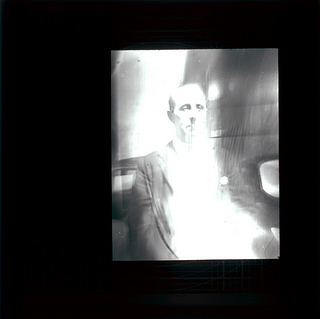
Tyne & Wear Archives & Museums
Ladies, are you tired of wispy hair, or ectoplasmic break outs spoiling your best attempts at being captured on film? Do you dread the sight of a camera, and seek to hide in the shadows? There’s no need to be so bashful – our team can primp and preen even across the Veil!
So if you want to appear in family portraits, and enjoy the gaze of the camera even after the final sleep, then come and see Reginald Flow and his amazing make-up assistant, Petronella the Great – we’ll always capture your best side, even though you’re on the Other Side!
* * *
This image comes from a series of lantern slides, titled ‘Psychic Photography From A New Angle’ and feature eerie images of the supposedly paranormal and unknown forces caught on camera.
June 8, 2015
How To Cope With Being Lonely
Back in April, the Guardian published a piece on loneliness. Apparently 83% of 18-34 year olds feel lonely. Well I’m in that particular demographic and I can attest to that. I’m an introvert and I do like my own company, being happy to go to the cinema or even out for dinner on my own, but sometimes you do just want to share experiences with other people.
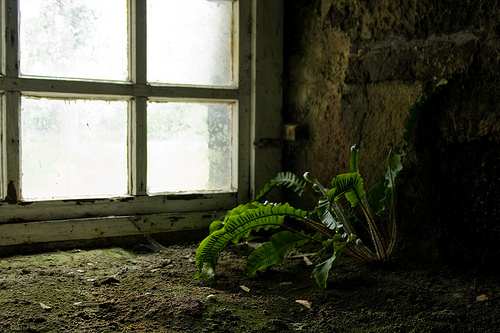
© Icy Sedgwick 2010 – Lonely weed
Funnily enough, I sometimes wonder if social media hasn’t made it worse – there’s nothing like sitting at home scrolling through Facebook and realising the world is at a party you weren’t invited to. Of course that ignores the obvious – that there are times in your life when you’re the one at the party, and someone else is sitting at home feeling lousy!
Still, loneliness is something I think we all feel from time to time, and sometimes more keenly than others. You might be a first time mother in an area where play groups are hard to find and other mothers won’t admit you to their clique. You might have moved to a new city and struggle to make friends. Maybe you’re a writer and you spend so long in your own head you’ve forgotten how to connect with others.
Or maybe you spend a lot of time with other people, be they friends, family or colleagues, and you still feel alone.

© Icy Sedgwick 2013 – Sometimes you can be surrounded by people and feel lonely
When I originally decided to write this piece, I was feeling exceptionally low, and I wanted to explore the reasons for feeling lonely. I got dumped a couple of weeks ago, meaning all of the plans I’d had suddenly fell apart. I was faced with all of this time that I suddenly didn’t know what to do with. Sure, I’ve got research, writing and editing to be doing, but I didn’t want to stay stuck in theand that’s naturally fed into my state of mind, even though I’ve never been busier. Trouble was, in my head it became more of a self-indulgent pity party, and that’s precisely the reason why I don’t often post overly honest blog posts (plus I often think no one really cares).
So instead I’ve decided to talk about three ways you can take back your loneliness and make it work for you. I’m speaking from experience here, and this is also a culmination of the wisdom I’ve gleaned from speaking to friends about how isolated I sometimes feel. Though there’s a lot to be said for loneliness. Being around people all the time is exhausting, and sometimes you just need space to think, and do your own thing. It’s liberating.

1) Learn to appreciate your own company
Often loneliness and boredom go hand in hand. If you’re on your own but you’re busy, you don’t really notice you’re on your own. So find strategies for helping you to pass the time when you’re not around other people. Put the smartphone down and stop checking Facebook. There’s a whole wealth of interesting documentaries both on TV and online. Start a new online course through a website like Coursera. Take up a new hobby. It’s a good idea to not just appreciate your own accompany, but to actively look forward to having time to yourself. It gives you the time and space to do what you want to do!
The benefits of this are twofold. On the one hand, you have something cool to show for your time, and it gives you something interesting to talk about when you do manage to catch up with friends, or you find yourself in a conversation with someone by the photocopier at work. On the other hand, new hobbies and interests also put you in a position to spend time with new people who do the same things as you. Most importantly, you’re doing something entirely for yourself. Win!
2) Be your own boss
There’s nothing worse than making plans with other people, only to have everyone flake out and drop you at the last minute. They probably don’t mean to, but they all assume that everyone else will still go to whatever you had planned, not realising that if they all assume that, no one ends up going! True, making plans with other people gives you more motivation to actually go and do things, but if you only make plans with yourself, you don’t have to worry about other people being unreliable. That’s not to say you can’t invite other people – you totally can – but make the plans for you, so if others can’t make it, you still can, and if they can make it, it’s a bonus.
I went to Alnwick by myself in December and had a very quiet day at the Alnwick Garden. It was almost deserted and yes, it did feel lonely, but there was something very peaceful at taking the day at my pace, and having the mental breathing room to take in the beauty of where I was.

Walled Garden at the Alnwick Garden
3) Loneliness doesn’t have to be permanent
Remember that life has a habit of throwing curve balls so if you’re lonely now, you don’t have to be lonely forever. If you’ve followed up suggestion 1, then hopefully any new hobbies or interests will get you out among more people. I can speak from experience here – when I lived in London, I joined two knitting groups and met some fabulous people, and now I’m single again I’m making an effort to go to more meetings from Meetup.com. I’ve found it hard, and my friends will know how anxious I get about going somewhere new to spend time with people I don’t know, but I’ve made myself do it. In between meet ups, or plans with friends, I do still feel lonely but that’s when I kick back to suggestion 1 and spend time working on projects for myself.

I drew this at the Ink & Drink meetup at the Laing art gallery
I’ll be honest. None of this is easy. It’s difficult to go to social gatherings on your own – you’re convinced people are either ignoring you because you’re alone, or they’ve avoiding you because you’re clearly a social leper. That’s why finding events related to your interests are so helpful – even if no one really speaks to you, you still have the event itself to occupy your attention, and there are bound to be other newbies there too, who feel equally as anxious as you!
Naturally there are safety tips to bear in mind. Let someone know where you’re going, and don’t invite strangers to your house. Meet somewhere public, and don’t give too much away about where you work or live until you feel you can trust people. It’s true that there is safety in numbers, and humans are a social species so it’s natural to want company. But if you can learn to enjoy the times between the social events, it opens up a whole new world of possibilities.
How about you? Do you feel lonely, and if you do, what do you do to combat it?
June 5, 2015
#FridayFlash – The Hanging Tree

Image by Erikwkolstad
I stand at the edge of the forest, two of my branches extending over the still depths of the lake. Blue sky arcs above me, and birds fly overhead, dipping and wheeling in clear mountain air. I stand in a most picturesque spot – indeed, what better place could there be to send people to their final end?
It is beautiful, to be sure, but when a storm rolls in and the wind gathers strength, I fancy I can hear the creak of rope against my limbs. I feel the weight of the condemned swinging with every gust and spectral eyes glitter in the gathering gloom.
I have an odd sympathy for the dead. In essence, I am one of them. My leaves fell long ago and I could not muster the heart to grow new ones. My bark withered and died, encasing me in a shroud of hard wood. Humans exposed me to so much death that it became infectious.
Yet I am not truly dead. I still exist in a liminal state, nourished by the lives of those lost in my branches. I did not mean to, but I consumed 426 souls during my tenure as the Hanging Tree. Where else were the souls to go, but into my open and welcoming heart? Still, they cannot sustain me forever, as I absorb them one by one.
I only fear what will happen when the final soul is entirely snuffed out.
June 1, 2015
Your First Draft is Allowed to Suck!
If you’re anything like me, you probably spend a portion of your day keeping up with your contacts on Twitter. If you’re reading this blog, then many of your contacts are probably writers. As a result, you’ll probably see many tweets saying “I’ve got too much to do to get any writing done today”. You might even be one of the tweeters saying that. There are a thousand reasons why a writer might not be writing, and that’s ok. You don’t have to write every minute of every day. However, when a writer has the time and the inclination to write but chooses not, I’d venture to guess that the writer is afraid.

Fear to the Dark Side leads
Yep, I said it. Afraid. They’re either afraid that whatever they produce will be rejected when it’s sent on its merry way into the submission system, or they’re afraid it will be so bad it won’t even make it as far as this system. If they don’t write, then they can’t inflict a work of colossal “bad-ness” on the world, and all will be well (we’ll ignore those writers who end up unleashing terrible books on the world anyway – at least they were writing!). So let me break it to you as easily as I can… if you never write, then you’ll never know how bad it is, but at the same time – you’ll never know how good it is, either!
Even the professionals start somewhere
I can’t help thinking that we’re so hung up on the books that we’ve read that we expect ours to look the same when we’re finished writing. We understand the process involved, but for some reason we assume when it comes to other writers, they give birth to fully formed novels that ooze perfection from every correctly placed semi-colon. We forget that the writer no doubt spent hours tearing out his or her hair when a scene didn’t work the way they thought it should, or that this very same book has, at some point, existed as a manuscript covered in red pen.
It’s called a first draft for a reason!
The term “first draft” implies that the manuscript you hold in your hands is not finished – hence it being a “draft”. The very fact it is called the first draft implies there are more drafts to come. This is because no one expects you to get it right straight out of the box – if they did, you wouldn’t be writing your first draft, you’d be writing a novel, and editors everywhere would change career. Your first draft is the product of your inner hyperactive toddler, the one that gets distracted by all the new things and the shiny possibilities, who leaves plot lines hanging, gets character names wrong, and decides to change narrative direction halfway through. It’s supposed to look like that.
Get involved
The first draft is supposed to be exciting! Anything can happen – and frequently does! Humanity is a species that excels at making mistakes and then learning from them. So get stuck in, make some mistakes, and just run with the story. You can always go back (well, should go back) and fix things later. It’s ok if you write plotlines you never finish or switch allegiances between characters – no one need ever know, because you’ll smooth all these rough edges when you write your second draft.
It happens to all of us
Take it from someone who knows. I’m in the process of finishing a first draft for a novella and it’s a mess. It changes from third person past tense to first person present tense halfway through, there are currently no chapter breaks, and I’m sure one of my characters changed their name. My protagonist waited until I was almost finished to point out that he would like a different career – the one he suggested works better within the narrative, so I’m ending the book with my guy following his new career, meaning I need to edit the first three-quarters of work where he’s doing something else. There are plenty of other changes I’d like to make, but these are the main ones. Am I bothered? No – because this is just the first draft. I’ll go back and make my changes in the second draft.

Now, write!
Remember the cardinal rule of writing – you can’t edit a blank page. That blank page is just a piece of paper – whereas a first draft is raw material that can be honed. Michelangelo didn’t go to the quarry and find David embedded in the rock – he had to coax the statue out of the marble. Your first draft is that hunk of marble, and it’s only once you’ve written it that you’ll get to start chipping away to find the art inside. So go get your hunk of marble, and see what you can produce!
Images courtesy of Graham Binns and Dark Botxy.
Other posts in my creativity series;
Why Having Too Many Ideas Is As Bad As Not Having Enough
Can rules help or hinder creativity?
Why Do You Sometimes Need To Fail?
May 29, 2015
#FridayFlash – The Wilson Street Mission
 Two weeks after my roommate’s boyfriend moved in, I started taking my evening meals in the diner two doors down from our building on Wilson Street. It was the only way I could get any peace; Cody didn’t know what the word ‘quiet’ meant, and the TV was permanently tuned to the sports channels. He ate like a pig at a trough, and Lesley was too grateful to have a boyfriend to say anything.
Two weeks after my roommate’s boyfriend moved in, I started taking my evening meals in the diner two doors down from our building on Wilson Street. It was the only way I could get any peace; Cody didn’t know what the word ‘quiet’ meant, and the TV was permanently tuned to the sports channels. He ate like a pig at a trough, and Lesley was too grateful to have a boyfriend to say anything.
The diner was the kind of place where the staff know the regulars, and no one talks unless they have something to say. I started sitting at one of the tables by the window, my netbook open in front of me, where I could write and watch the street as I ate. I often stayed an hour or so after I’d finished eating, and Phyllis would ply me with black coffee and nibbles.
The Wilson Street Mission was across the road from the diner. People would drop by alone or in pairs every night, but on a Wednesday, a whole congregation would turn up. I’d watch maybe fifty people pile into that old red brick building, and at 7:30pm sharp, the doors would close, and I’d watch the light show against the stained glass windows at the front of the Mission. By the time I left an hour later, they were all still in there.
I watched this go on for a month – one night, I even tried to see if they were still there at midnight, but our apartment was on the wrong side of the building, and I didn’t want to venture into our street so late at night.
One Wednesday night, as Phyllis was taking away my soup bowl and pouring me another coffee, I asked her about it. She shook her head at me.
“No, I don’t know nothin’ about that Mission there, ‘cept it does a lotta good work for folk in this neighbourhood.”
“Why’s it so busy on a Wednesday?”
“I guess the pastor got somethin’ special to say.”
I knew Phyllis wasn’t telling me everything but there was nothing I could do – if she didn’t want to tell me, then I couldn’t make her. I decided to stay a little later that night – the diner closed at 10pm, so I settled down with my coffee, and a slice of cheesecake, and started writing.
The diner was empty by 9, and Phyllis went home, leaving just Cathy working the front. Marco pottered around out back, bursting into snippets of opera he’d picked up back home. Cathy never spoke to anyone, so I didn’t bother asking her about the Mission, and she didn’t ask why I was working late. She just brought me another coffee, and went back to cleaning the counter.
My intention had been to see when the congregation left the Mission, but I got engrossed in my work and forgot to look. I’d made good progress on my novel when Cathy coughed, and looked at the clock. 9:55pm. I nodded, shut down my netbook, and paid my check. As I left the diner, I noticed the Mission’s doors were still closed, and the light behind the stained glass windows was throwing coloured shapes across the road. A chorus of singing voices filled the late night air, and echoed along the empty street. It sounded beautiful and haunting at the same time, and I couldn’t stop myself from crossing the road.
The information board outside the Mission featured special events or forthcoming visits by doctors and priests, but it was blank for Wednesday night. I tried to look through one of the windows but they were too high up in the wall. The singing definitely came from inside, but the congregation sounded like a lot more than just fifty people.
On a whim, I tried the door. The handle stuck at first, but I put all my weight on it, and the door opened. I pushed it inwards with my fingertips, hanging back in case anyone came to see what I wanted. I expected someone to rush over and send me packing, but no one came. Feeling bolder, I poked my head around the edge of the door.
I expected to see a congregation, enraptured and following an enthusiastic pastor, with bright lights shining behind him, lights that I could see outside through the stained glass. Instead, the building was empty and in darkness. I figured it would be like the old soup kitchen four blocks over, but it was laid out like a theatre. A layer of dust covered the velvet flip seats that faced a platform at the end of the room – no one had been inside for years.
I couldn’t hear the singing any more, or see the light, so I turned to leave. The door swung shut in my face, and the darkness swallowed me up. I felt around on the door for the handle, but there was nothing on the inside, just smooth black wood. Suddenly, a voice broke the silence.
“Good evening, Celine. We’ve been expecting you.”
A hand touched my shoulder and I screamed.
I’ve been screaming ever since.
May 25, 2015
Why Do You Sometimes Need To Fail?
In my Creativity series, I’ve talked about why having too many ideas can be as bad as having too few, and the value of creative rule systems. Today I want to talk about something that is currently very close to my heart.
It is perfectly okay to not be excellent at everything you do first time out. You are allowed, nay encouraged, to suck at stuff.

Failing is something that humans do a lot – it’s why we have version control. Trouble is, we’re constantly bombarded with images of perfection that we feel we can’t fail, or everyone around us will instantly flick into judgemental mode.
It’s also something that happens a lot to creative types, and it’s something that can easily provoke all kinds of crises when it does happen. From the failure of the absymal first draft that you’d rather use as toilet paper to the attempt at a new painting medium that turns your creative output into something fit only for your mother’s fridge door, we panic when we fail. We’re supposed to be good at this stuff, right?
Well you have two choices. You can fail, and give up. Or you can fail, grimace, and have another go.
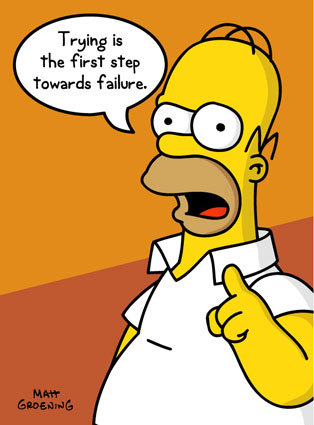
Don’t be like Homer.
1) If at first you don’t succeed…improve it later.
Some people are perfectly okay with failing, and they’re able to look at why they failed, and improve that little aspect so that next time they do better. It’s a process of constant refinement. This is essentially the point of failure – it forces you to get things right. If you continually succeeded first time round, you’d get bored, because you’d never be challenged – and whatever you did do would end up sub-standard because you’d never have to try. But if you constantly have something to tweak, streamline or practice, you have something that inspires and motivates you to get better at whatever it is you’re trying to do.
After all, you can’t get into a car for the first time and expect to drive like Lewis Hamilton, so why would you try writing and berate yourself for not immediately being J. R. R. Tolkien?
2) Don’t pressure yourself to succeed first time out.
Occasionally you’ll have a go at something and be a natural. It’ll all fall into place, and you’ll think “Hey, this is easy!” If that happens, then go with it. Embrace it. But remember that you’ll still need to practice. But if it doesn’t happen, and in all honesty it probably won’t, then don’t berate yourself for it. Ask yourself this – did you enjoy whatever it was you tried? If you didn’t, are you likely to enjoy it if you improve? If you did, then don’t you want to continue doing it just for the enjoyment of it? After all, the more you do something, the better you’ll get anyway. It’s just practice.
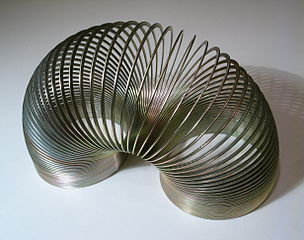
Picture by Roger McLassus
3) Use mistakes to your advantage.
Not every mistake is a bad thing. The slinky, penicillin, potato chips, pacemakers, microwaves, Scotchguard and Post-It notes all started out when their creators tried to do something else. Just because something doesn’t turn out the way you wanted it to doesn’t necessarily mean it’s wrong – it’s just different, and could potentially be better. So that historical romance you tried to write which turned into steampunk, or the political thriller that became a sci-fi epic, isn’t a mistake, it’s just not your original intention.
Whether you ultimately improve or not is entirely up to the amount of time you do, or don’t, devote to practice, but don’t immediately give up as soon as you fail. Just try again!
May 22, 2015
#FridayFlash – Homemade Gods

Los Angeles County Museum of Art, via Wikimedia Commons
“Night night, Ekkor.” Pyotr leaned into the child’s bedroom to snuff out the candle.
“No, I want a story first!” Ekkor held his blanket up to his chin, eyes wide in the flickering light. His gaze kept returning to the crude wooden figures on his window sill. Pyotr sighed – there would be no sleep for his nephew if he didn’t come up with a story.
“Alright then, but just a short one. What kind of story shall it be?”
“Tell me about the homemade gods.” Again Ekkor looked at the figures at the window. One of them still bore a smudge of blood on his back, testament to Pyotr’s youthful ineptitude at carving.
Pyotr crossed the room and perched on the edge of Ekkor’s bed.
“Long ago, our people realised that the gods weren’t detached beings that lived in the clouds, they were actually part of the world around us. People could call on what they needed, and get through tough times. But one day a very clever man realised that if he made a figure and gave it a name, it bound that quality to the figure, and it was easier to use it again in future.
“The only problem was, if someone else called your figure by its name, then you lost your claim over it, and the other person could use it against you. A grandfather found that out the hard way when his grandson asked him the names of his gods. The grandfather told him, thinking he might need to use them if he was out at the market and the grandson was at home, but then the grandson used the names to command the gods.”
“What did he do with them?” Ekkor whispered from beneath his blanket.
“He got them to hurt his grandfather so he would inherit his land.”
“That’s awful!”
“It is. So people started to make sure they didn’t share the names of the gods they created with anyone else. But the gods were crafty, and they made sure that a person couldn’t command them to attack someone else who had gods of their own, and so peace came to our little corner of the world.”
“What does that one do?” asked Ekkor in a tiny voice. His finger appeared at the hem of his blanket, and he pointed at the figure on the windowsill.
“He is for protection, he’ll stand guard over you. People with gods of their own might not send harm, but there are other things in this world that will. But you don’t need to fear them while he is here.”
“What’s he called?”
Pyotr laughed, and stood up.
“I’m not falling for that, Ekkor! Just rest assured that he’ll look after you, as will I. Now get some sleep. You’re perfectly safe here.”
Pyotr ruffled Ekkor’s hair and snuffed out the candle on his way out of the room. He followed the passage away from the sleeping quarters and into his workshop. More figures lay on his bench in various stages of completion, some carved from wood, and others sculpted in clay. He picked up his knife and a small man with the head of a ram and the tail of a lion. Moments later, a handful of wood shavings lay on the floor, and the finished figure was in his hand.
He raised the figure to his lips and whispered into its ear.
“I name you Hok-Pyr-Wyrd, and you will guard against inquisitive minds seeking names they are not to know.”
Pyotr took the figure to the front door of the house, and stood it on a shelf with a range of other homemade gods. He moved Hok-Pyr-Wyrd so that he faced the sleeping quarters, and headed towards his own bedroom.
He might have caught out his grandfather but his nephew would not pull the same trick on him.
This flash was inspired by a comment from Nerine Dorman about a misspelling, turning homemade goods into DIY deities!

